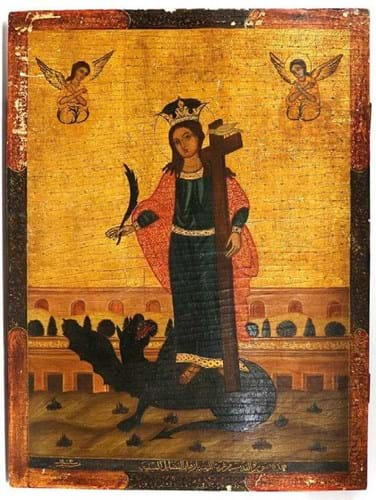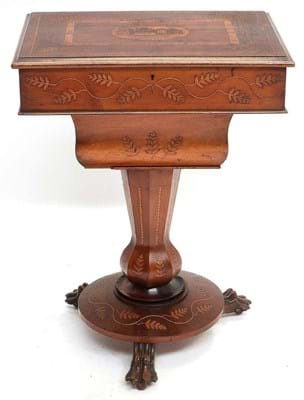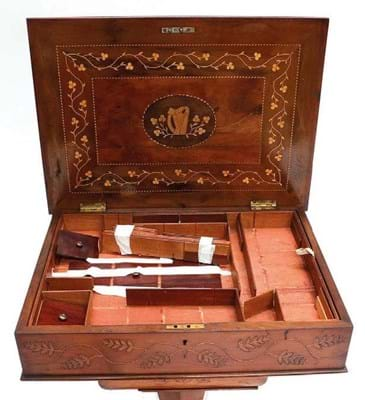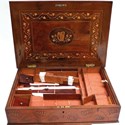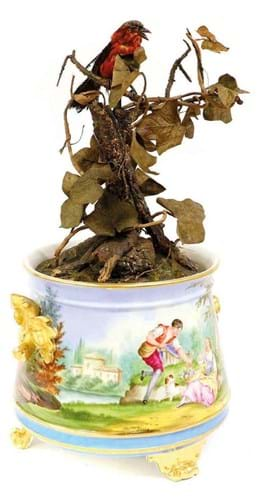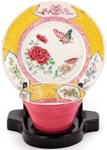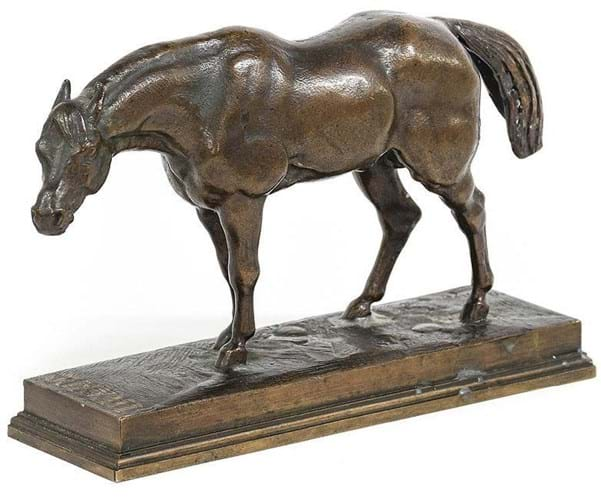
Louis Antoine Barye’s bronze of a half-blood horse with head lowered which led Tennants’ Country House sale on £10,000.
The Country House event from January 12-13 at Tennants (24% buyer’s premium) numbered around 1000 lots and included several designated consignments, among them items from the Terry family of York, of chocolate fame, selected contents from Dutton Manor in Lancashire and ceramics from a collection in the Isle of Man.
But it was a different source that yielded the Leyburn sale’s top-seller: a bronze animalier sculpture.
Antoine Louis Barye (1796-1875) is one of the best known and most celebrated in a long line of French animalier sculptors and his Cheval Demi-Sang Tête Baissée (a half-blood horse with head lowered) is a model that comes up for sale relatively regularly.
The example at Tennants, which measured 7in (17.5cm) in length and was set on a rectangular stepped base, was inscribed in gilt CLXXIII, and signed BARYE and BARYE2.
Tennants’ specialist Andrew Parker had felt that the bronze, which was estimated at £500-700, was a posthumous cast but given that the bidding on sale day soared to £10,000 he said perhaps the bidders thought it might have been cast a bit earlier.
Saint depicted
Also making far more than predicted at £5000 against an estimate of just £200-300 was a wooden icon panel measuring 2ft 2in x 20in (68 x 51cm) depicting St Margaret of Antioch and showing the saint holding a cross and a palm frond while standing on a dragon with two angels in the top corners and an inscription along the base.
Consigned by a North Yorkshire client, the cataloguing gave little other information beyond describing it as Middle Eastern school but without attribution to any date or country of origin.
Margaret of Antioch, who was born in what is now modern-day Turkey, is a saint in both western and eastern Greek orthodox Christianity and the Coptic church (although the inscription along the base of the icon looks to be in Arabic rather than Roman or Greek script). Tortured for refusing to renounce Christianity, she was swallowed by the devil in the shape of a dragon, from whom she escaped alive when the cross she carried irritated the animal’s interior.
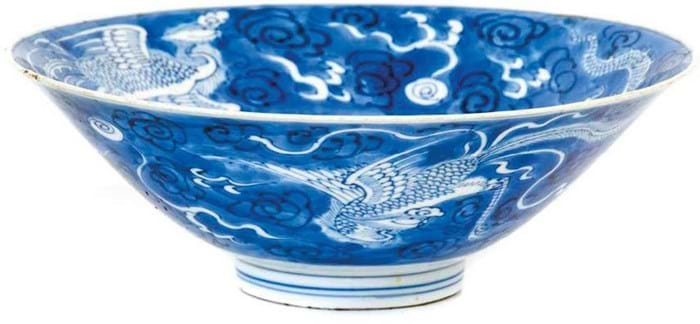
Chinese porcelain conical bowl, one of the lots consigned from the Terry family of York, £2200 at Tennants.
Chinese porcelain in the sale was boosted by input from the Terry and Dutton Manor consignments.
The most expensive at £2800 was a lot containing two 19th century blue and white ginger jars both with pierced wood covers. Standing 8 and 8¼in (20 and 21cm) high, both were painted with cracked ice and prunus grounds: one featuring panels of various precious objects, the other (which bore a label for J.R. Kidson, China Dealer, Leeds), with panels of kylin.
From the Terry family came an 8½in (22cm) diameter porcelain bowl of conical shape painted with dragons and phoenix on a cloud scroll ground. It bore a six character Chenghua reign mark but was catalogued as probably 18th century rather than from the 15th and made £2200 against a £300-500 guide.
Of note among the antique furniture was an example of Killarney marquetry from the mid 19th century.
This was in the form of a 2ft 5in (76cm) high fitted work table on a tapering support and base (a favoured shape for displaying this kind of Irish inlay work) and was composed of yew and arbutus wood decorated and inlaid with an oval panel of a ruined abbey to the lid as well as with scrolling trails of leaves. It made £2200 (estimate £600-800).
There was also a strong price for a smaller example of marquetry - a 5½in high oval 19th century tea caddy in green stained and inlaid satinwood with stained bone escutcheon and bone knops to the outer and inner cover. It easily outpaced a modest £150-200 guide to take £1200.
Another lot to exceed expectations, making £2000 against predictions of £300-500, was an 18in (46cm) high French clockwork powered singing bird automaton dated to c.1900 set in a Paris porcelain jardiniere painted with panels of figures in landscapes.
Packed programme

A good deal of interest emerged at Tennants for this set of appliqué buttons dated to the first half of the 19th century. Each measured 1½in (4cm) in diameter and was worked in feathers and seeds with a design of a bird perched in a branch and mounted under glass. They were in good overall condition with minimal wear and dents, although all but one had lost its shank and there was some loose material inside the button cases. Notwithstanding, they were an attractive ensemble and a relatively rare survival as a set and ended up making £1500 against predictions of £200-300.
The Country House sale was among a full crop of auctions at the Leyburn firm to kick off 2024. They also included a 900-lot-plus Antiques and Interiors sale on January 5, stamps on January 10, and a dedicated silver and jewellery auction also on the 13th.
In all, Tennants sold over 2600 lots for a total hammer price of over £838,000 in the first two weeks of the year.
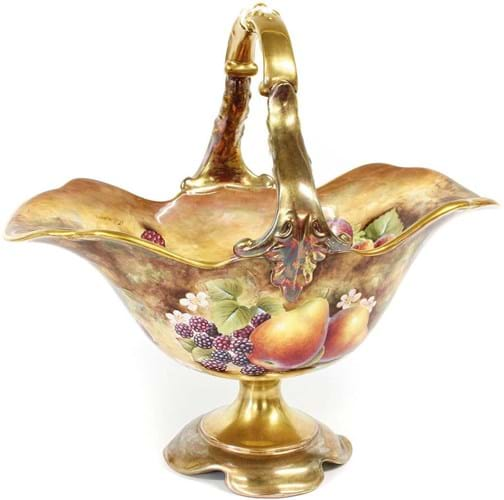
There were a number of examples of Royal Worcester porcelain among the top prices in Tennants’ auction. Pictured here was the most expensive: an 11in (28cm) wide basket on a pedestal base painted inside and out by Jason Bowman with an array of fruits and signed and marked. It went for £4500.
“It has been an incredibly busy and buoyant start of the year, with packed viewings and strong prices achieved for our clients”, said auctioneer Jane Tennant.
“We have been privileged, too, to have sold property from numerous private estates across the country, and a fantastic selection of jewellery, watches and silver which totalled in excess of 600 lots alone”.
Manchester races

Punching well above its size and weight to take one of the higher prices in Tennants’ January 13 sale of jewellery, watches and silver was a silver racing badge or token which was bid to £1000, a multiple of the £250-350 guide.
The oval token measuring just 2in (5cm) wide and weighing 18dwt (50grams), was marked for Isaac Simmons, Sheffield, 1846. It was engraved Manchester New Race Course Association on a garter and Established 1847 while the reverse was engraved Mr John Greenwood.

Racing badge or token for the Manchester New Race Course Association, £1000 at Tennants.
Various venues were used for horse racing around Manchester from at least the middle of the 17th century, though none of the courses were actually in Manchester itself.
The course for which this badge is engraved was on a site near the river Irwell, Irwell Castle, which was rented on a 20-year lease from 1847- 67 from the Member of Parliament and owner of the Pendleton Colliery, John Fitzgerald.
It had a 1000-seat stand which offered a view of the entire course. After the initial lease expired, Fitzgerald’s son, who inherited the estate, declined to renew it and so the course was closed and moved to New Barns, Weaste.
In 1902 the land at Weaste was acquired by the Manchester Ship Canal Co and racing moved back to Castle Irwell after the race committee purchased that land from the executors of John Fitzgerald’s son.
The John Greenwood whose name is engraved on the reverse is very probably the one born in 1788 who is known for being a transport entrepreneur and keeper of a toll-gate in Pendleton on the Manchester to Liverpool turnpike.
He went on to purchase a horse and carriage to be used for an omnibus service between Pendleton and Manchester which did not require prior booking, and died in 1851 leaving a successful business to his son.
Another example of this badge, though without a name engraved on the reverse, was sold at Noonans, London, in December 2016 for £650.
Regimental silver
Included in these auctions was a collection of regimental silver sold by order of the Royal Regiment of Fusiliers to benefit the Fusiliers’ Aid Society.
Among its highlights was an oversized 17¾ in (45cm) claret jug and a pair of goblets made in Birmingham in 1880 by Frederick Elkington. Presented to the Second Battalion of the 20th (East Devonshire) Regiment by Lieutenant A Montgomery to mark his marriage, they sold for £2500.


